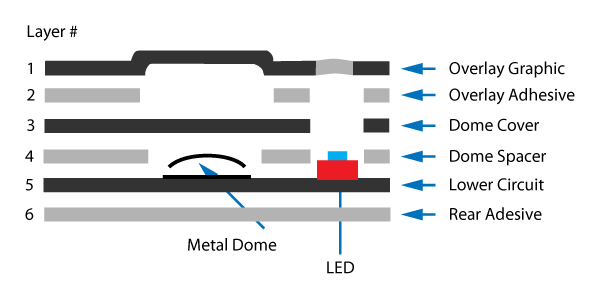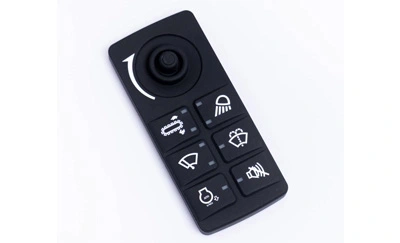Recognizing the Importance of Membrane Layer Change in Modern Electronic Devices
Membrane layer switches are essential elements in contemporary electronic devices. They offer a mix of capability and style that improves user communication. Their long lasting and lightweight nature makes them suitable for numerous applications. As markets develop, the demand for modification and progressed functions grows. Understanding just how membrane switches add to development reveals their value fit the future of electronics. What exists ahead for this technology?
The Essentials of Membrane Switch Over Innovation
Commonly neglected, membrane layer switch innovation plays an important function in the modern-day electronics landscape. These tools, composed of numerous layers, act as interface for various electronic products, varying from family devices to clinical equipment. A normal membrane layer switch includes a graphic overlay, a spacer layer, and a circuit layer, which are thoroughly assembled to produce a useful interface.When pressure is applied to the overlay, the circuit layer is finished, enabling signals to be sent to the device. This innovation is recognized for its flexibility, making it possible for customization in form, design, and performance to meet details user needs. Furthermore, membrane layer buttons are slim and light-weight, making them suitable for applications where area is a costs. Their longevity and resistance to environmental elements even more improve their charm, guaranteeing they can hold up against severe problems while keeping functionality. On the whole, membrane layer button technology is integral to creating efficient and user-friendly digital tools

Key Advantages of Membrane Layer Changes
Membrane switches deal a number of key benefits that make them a favored option in various digital applications. Their style enables a portable type element, making it possible for makers to produce lightweight and streamlined tools. In addition, membrane layer switches are immune to dirt, dampness, and chemicals, which enhances their durability and durability in requiring atmospheres. The responsive comments provided by these switches can improve user experience, making them instinctive and simple to operate.Furthermore, membrane layer switches can be tailored with diverse graphics and colors, permitting distinct branding chances. The production procedure is generally economical, especially for high-volume manufacturing, as it reduces setting up time and streamlines design. Ultimately, membrane layer changes call for minimal maintenance, adding to lower general functional costs. These advantages highlight their expanding appeal in modern electronics, where dependability and straightforward user interfaces are vital.

Applications Across Numerous Industries
The convenience of membrane switches enables their widespread fostering across different industries. In the clinical field, they are commonly made use of in diagnostic equipment and person tracking systems, supplying a resilient interface immune to impurities. The vehicle sector utilizes membrane buttons for dashboard controls, boosting user experience with streamlined designs that hold up against severe problems. In consumer electronic devices, they work as control panels for tools such as microwaves and coffee machine, giving an easy to use user interface that is easy to tidy. The aerospace sector utilizes membrane layer switches in cockpit controls, where integrity and space effectiveness are extremely important. Additionally, the industrial field leverages these switches in machinery and control systems to ensure durable operation in requiring settings. This broad variety of applications highlights the flexibility of membrane switches, making them essential parts in boosting functionality and user communication throughout varied technical landscapes.
Customization and Style Versatility

Future Trends in Membrane Switch Over Growth
Arising fads in membrane layer button advancement suggest a growing emphasis on boosted capability and assimilation with clever modern technologies. As customer demand for much more advanced electronic devices rises, suppliers are concentrating on producing membrane changes that not only serve standard functional functions but also incorporate features like touch level of sensitivity, backlighting, and haptic feedback.Furthermore, developments in materials are anticipated to boost toughness and ecological resistance, making membrane switches over appropriate for diverse applications in sectors such as health care, automobile, and consumer electronics. The assimilation of capacitive touch modern technology is most likely to become a lot more widespread, enabling for sleeker designs and boosted user interfaces. membrane switch.Additionally, the surge of the Web of Things (IoT) is motivating the advancement of membrane layer changes that can communicate wirelessly with various other devices, boosting interconnectivity. In general, the future of membrane switch modern technology shows up promising, driven by advancement and the pursuit of straightforward solutions
Frequently Asked Questions
Just How Do Membrane Switches Over Compare to Traditional Mechanical Buttons?
Membrane buttons, being much more space-efficient and using a sleek layout, contrast with typical mechanical buttons that offer tactile responses. The former typically feature personalized graphics, while the latter usually guarantee durability and reliability in numerous applications.
What Products Are Frequently Utilized in Membrane Layer Switch Production?
Membrane buttons are usually generated using materials such as polyester, polycarbonate, and printed conductive inks. These products provide flexibility, resilience, and responsiveness, making them appropriate for numerous applications in digital helpful hints tools and customer interfaces.
Can Membrane Layer Switches Be Fixed or Recycled?
Membrane buttons can often be repaired, specifically if small problems develop, such as glue failure or surface damage. Full reuse is normally limited due to wear and prospective deterioration of materials over time.
Just How Do Ecological Elements Influence Membrane Switch Efficiency?
Environmental variables, such as temperature, exposure, and humidity to chemicals, considerably influence membrane button performance. Severe conditions can result in deterioration, affecting responsiveness and longevity, inevitably endangering the capability of the gadget in numerous applications.
What Is the Normal Lifespan of a Membrane Layer Switch?
The regular lifespan of a membrane layer button normally varies from 1 to 5 million actuations, depending upon variables such as use frequency, ecological problems, and the products utilized in production, impacting longevity and performance durability. A regular membrane switch is composed of a visuals overlay, a spacer layer, and a circuit layer, which are carefully set up to develop a functional interface - membrane switch.When pressure is used to the overlay, the circuit layer is finished, allowing signals to be transferred to the gadget. The responsive responses provided by these switches can enhance individual experience, making them instinctive and very easy to operate.Furthermore, membrane layer buttons can be tailored with varied graphics and shades, permitting for unique branding opportunities. As consumer demand for much more advanced electronic gadgets boosts, makers are concentrating on developing membrane layer changes that not just offer fundamental operational functions but likewise incorporate features like touch sensitivity, backlighting, and haptic feedback.Furthermore, developments in materials are expected to boost durability and environmental resistance, making membrane layer switches over appropriate for diverse applications in industries such as healthcare, auto, and customer electronic devices. The combination of capacitive touch innovation is likely to become extra widespread, enabling for sleeker styles and improved customer interfaces.Additionally, the rise of the Internet of Things (IoT) is triggering the growth of membrane layer changes that can interact wirelessly with other devices, boosting interconnectivity. Membrane layer switches, being more space-efficient and supplying a streamlined style, contrast with typical mechanical buttons that supply tactile feedback